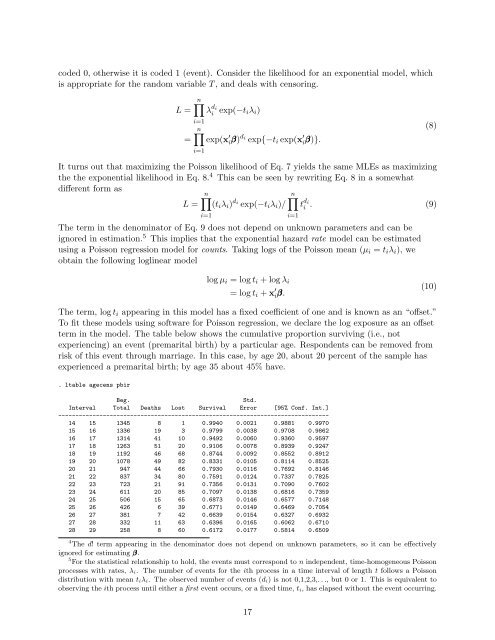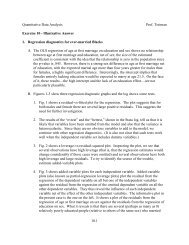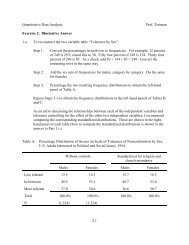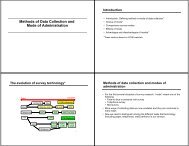Notes on Poisson Regression and Some Extensions
Notes on Poisson Regression and Some Extensions
Notes on Poisson Regression and Some Extensions
You also want an ePaper? Increase the reach of your titles
YUMPU automatically turns print PDFs into web optimized ePapers that Google loves.
coded 0, otherwise it is coded 1 (event). C<strong>on</strong>sider the likelihood for an exp<strong>on</strong>ential model, whichis appropriate for the r<strong>and</strong>om variable T , <strong>and</strong> deals with censoring.L ==n∏i=1λ d iiexp(−t i λ i )n∏exp(x ′ iβ) d iexp{−t i exp(x ′ iβ)}.i=1(8)It turns out that maximizing the Poiss<strong>on</strong> likelihood of Eq. 7 yields the same MLEs as maximizingthe the exp<strong>on</strong>ential likelihood in Eq. 8. 4 This can be seen by rewriting Eq. 8 in a somewhatdifferent form asL =n∏n∏(t i λ i ) d iexp(−t i λ i )/i=1i=1t d ii . (9)The term in the denominator of Eq. 9 does not depend <strong>on</strong> unknown parameters <strong>and</strong> can beignored in estimati<strong>on</strong>. 5 This implies that the exp<strong>on</strong>ential hazard rate model can be estimatedusing a Poiss<strong>on</strong> regressi<strong>on</strong> model for counts. Taking logs of the Poiss<strong>on</strong> mean (µ i = t i λ i ), weobtain the following loglinear modellog µ i = log t i + log λ i= log t i + x ′ iβ.(10)The term, log t i appearing in this model has a fixed coefficient of <strong>on</strong>e <strong>and</strong> is known as an “offset.”To fit these models using software for Poiss<strong>on</strong> regressi<strong>on</strong>, we declare the log exposure as an offsetterm in the model. The table below shows the cumulative proporti<strong>on</strong> surviving (i.e., notexperiencing) an event (premarital birth) by a particular age. Resp<strong>on</strong>dents can be removed fromrisk of this event through marriage. In this case, by age 20, about 20 percent of the sample hasexperienced a premarital birth; by age 35 about 45% have.. ltable agecens pbirBeg.Std.Interval Total Deaths Lost Survival Error [95% C<strong>on</strong>f. Int.]-------------------------------------------------------------------------------14 15 1345 8 1 0.9940 0.0021 0.9881 0.997015 16 1336 19 3 0.9799 0.0038 0.9708 0.986216 17 1314 41 10 0.9492 0.0060 0.9360 0.959717 18 1263 51 20 0.9106 0.0078 0.8939 0.924718 19 1192 46 68 0.8744 0.0092 0.8552 0.891219 20 1078 49 82 0.8331 0.0105 0.8114 0.852520 21 947 44 66 0.7930 0.0116 0.7692 0.814621 22 837 34 80 0.7591 0.0124 0.7337 0.782522 23 723 21 91 0.7356 0.0131 0.7090 0.760223 24 611 20 85 0.7097 0.0138 0.6816 0.735924 25 506 15 65 0.6873 0.0146 0.6577 0.714825 26 426 6 39 0.6771 0.0149 0.6469 0.705426 27 381 7 42 0.6639 0.0154 0.6327 0.693227 28 332 11 63 0.6396 0.0165 0.6062 0.671028 29 258 8 60 0.6172 0.0177 0.5814 0.65094 The d! term appearing in the denominator does not depend <strong>on</strong> unknown parameters, so it can be effectivelyignored for estimating β.5 For the statistical relati<strong>on</strong>ship to hold, the events must corresp<strong>on</strong>d to n independent, time-homogeneous Poiss<strong>on</strong>processes with rates, λ i. The number of events for the ith process in a time interval of length t follows a Poiss<strong>on</strong>distributi<strong>on</strong> with mean t i λ i . The observed number of events (d i ) is not 0,1,2,3,. . ., but 0 or 1. This is equivalent toobserving the ith process until either a first event occurs, or a fixed time, t i, has elapsed without the event occurring.17
















